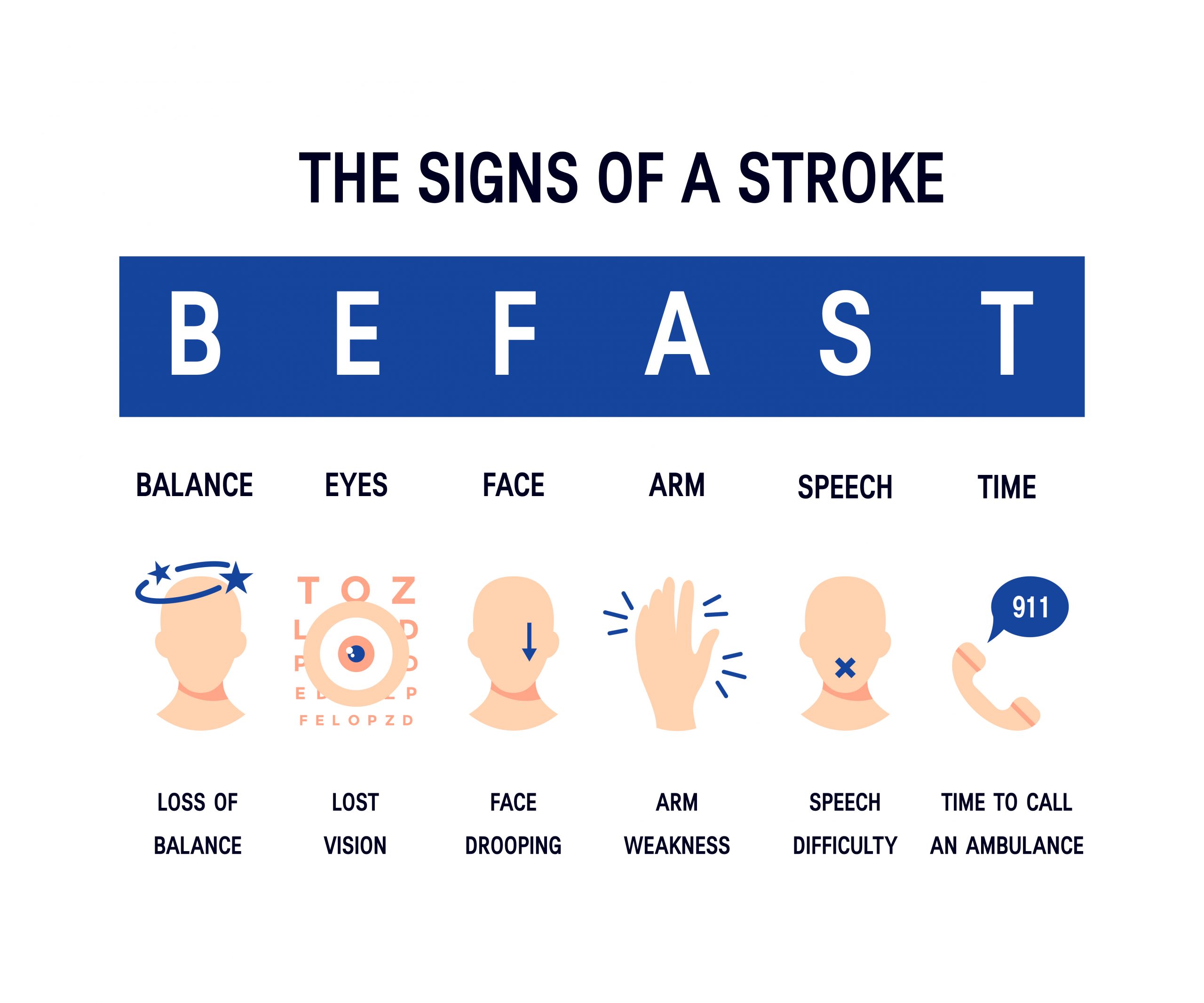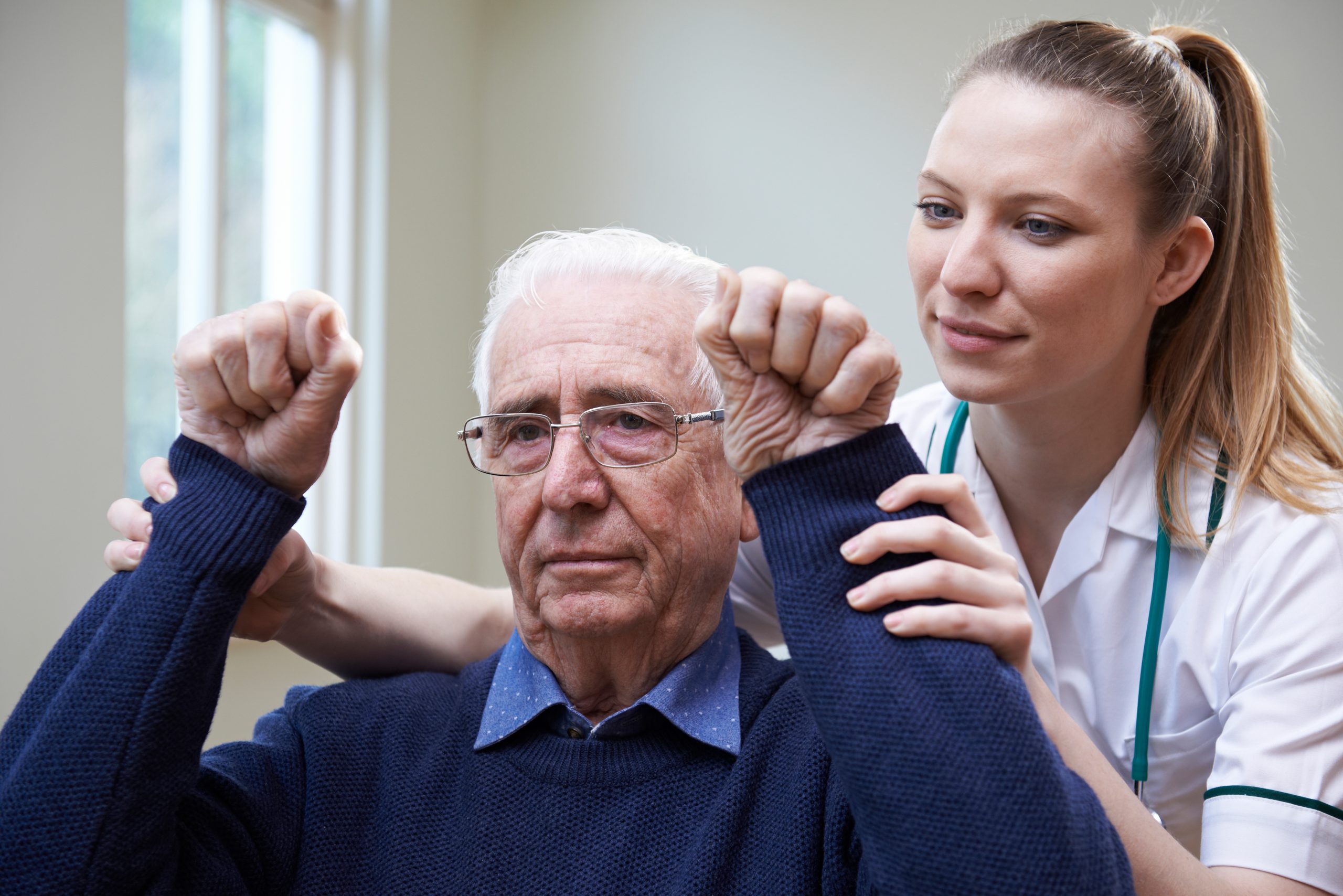Stroke:
Helpful Information and Resources
According to the CDC, stroke kills 140,000 Americans each year. That is approximately 1 out of every 20 deaths.
A stroke occurs when your brain suffers a loss of blood to the key areas of the brain. These brain cells lack the necessary oxygen and nutrients found in the bloodstream. As a result, they begin to die within just a few minutes. This can result in lasting brain damage, permanent disability or death.
A stroke requires immediate medical attention, so be sure to call 911 right away. Timely intervention will increase the likelihood of rehabilitation and recovery.

Types of Stroke and Risk Factors
There are two main types of stroke:
- Ischemic stroke: This is caused by a blood clot blocking a blood vessel in the brain. It’s also the most common type of stroke.
- Hemorrhagic stroke: This type of stroke occurs when a blood vessel ruptures and bleeds into the brain.
Another condition similar to a stroke is a transient ischemic attack (TIA), or a ‘mini-stroke’. A TIA occurs when there’s a temporary disruption to the brain’s blood supply. Any damage to the brain cells is not permanent. But if someone has a TIA, they have a higher risk of experiencing a stroke.
Risk Factors for a Stroke
Some of the risk factors include:
- High blood pressure: This is the main risk factor for a stroke.
- Diabetes
- Heart diseases: These conditions lead to blood clot formation which give a risk for strokes.
- A personal or family history of stroke or TIA.
- Age: As you get older, the risk of stroke increases.
- Race and ethnicity: Studies show that Black Americans have a higher risk of stroke.
Some of the additional risk factors include behaviors such as:
- Smoking: This activity damages your blood vessels and increases your blood pressure.
- Alcohol and substance abuse.
- Inadequate physical activity.
- High cholesterol levels.
- An unhealthy diet.
- Being obese.
Types of Stroke and Risk Factors
There are two main types of stroke:
- Ischemic stroke: This is caused by a blood clot blocking a blood vessel in the brain. It’s also the most common type of stroke.
- Hemorrhagic stroke: This type of stroke occurs when a blood vessel ruptures and bleeds into the brain.
Another condition similar to a stroke is a transient ischemic attack (TIA), or a ‘mini-stroke’. A TIA occurs when there’s a temporary disruption to the brain’s blood supply. Any damage to the brain cells is not permanent. But if someone has a TIA, they have a higher risk of experiencing a stroke.
Risk Factors for a Stroke
Some of the risk factors include:
- High blood pressure: This is the main risk factor for a stroke.
- Diabetes
- Heart diseases: These conditions lead to blood clot formation which give a risk for strokes.
- A personal or family history of stroke or TIA.
- Age: As you get older, the risk of stroke increases.
- Race and ethnicity: Studies show that Black Americans have a higher risk of stroke.
Some of the additional risk factors include behaviors such as:
- Smoking: This activity damages your blood vessels and increases your blood pressure.
- Alcohol and substance abuse.
- Inadequate physical activity.
- High cholesterol levels.
- An unhealthy diet.
- Being obese.

Stroke Symptoms
Stroke symptoms can arise very quickly and include sudden:
- Numbness or weakness of the face, arm or leg along one side of the body.
- Confusion, trouble speaking, or understanding speech.
- Trouble seeing in one or both eyes.
- Difficulty walking, dizziness, suffering from imbalance or loss of coordination.
- Severe headache for no reason.
If you believe that you or someone else is experiencing a stroke, then call 911 immediately.


![]()
Diagnosing Stroke
Medical professionals make a stroke diagnosis by:
- Inquiring about your symptoms
- Discovering your medical history
- Conducting a physical exam, which includes checks of:
- Your mental alertness
- Your balance and coordination
- Numbness or weakness in your face, arms, and legs
- Trouble speaking or seeing clearly
Performing tests such as:
- Diagnostic brain imaging (for example a CT scan or an MRI).
- Heart tests: to detect heart conditions, as well as blood clots that lead to a stroke.
- Electrocardiogram (EKG) and echocardiography tests.
![]()
Diagnosing Stroke
Medical professionals make a stroke diagnosis by:
- Inquiring about your symptoms
- Discovering your medical history
- Conducting a physical exam, which includes checks of:
- Your mental alertness
- Your balance and coordination
- Numbness or weakness in your face, arms, and legs
- Trouble speaking or seeing clearly
Performing tests such as:
- Diagnostic brain imaging (for example a CT scan or an MRI).
- Heart tests: to detect heart conditions, as well as blood clots that lead to a stroke.
- Electrocardiogram (EKG) and echocardiography tests.

Treating Stroke
The treatments for stroke include the use of medications, surgical interventions and rehabilitation. The treatment that each person gets depends on the type of stroke and the treatment stage.
There are three stages of treatment for a stroke:
- Acute treatment: used to stop a stroke when it’s happening.
- Post-stroke rehabilitation: to overcome any disabilities from a stroke.
- Prevention: to prevent another stroke from happening.

Acute Treatment: Ischemic Stroke
The treatment options include:
- Tissue Plasminogen Activator (tPA) to dissolve the blood clot. This medication is given to patients meeting certain criteria within 4.5 hours of the onset of stroke symptoms. The sooner you can get it, the greater the likelihood of stroke recovery.
- In cases where tPA isn’t possible, then other medications to stop blood cells forming clots may be administered. Alternatively, blood thinners may be given to keep existing clots from growing.
- In some cases of large artery blockage, procedures to remove the blockage can be used.
Acute Treatment: Hemorrhagic Stroke
The treatment options are as follows:
Blood Pressure Medications
Control of high blood pressure to prevent worsening or recurrent strokes is extremely important.
Aneurysm Clipping or Coil Embolization
If an aneurysm is the cause, then surgeries may be necessary to prevent further leaks from that aneurysm. They can also prevent any future rupture of the aneurysm. Appropriate referrals to the proper surgeons are necessary.
Arteriovenous Malformation (AVM) Repair
An AVM is a tangle of diseased arteries and veins that may rupture in the brain. If AVM caused the stroke, then the AVM repair includes:
- Surgery
- Injections of substances into the AVM to stop blood flow through it
- Radiation to shrink the AVM’s blood vessels.

Stroke Rehabilitation
Rehabilitation after a stroke can help you relearn valuable life skills. The aim is to help you reclaim your independence as soon as possible. It’s also important to take the necessary steps to prevent another stroke. Therefore, this will require a commitment to healthy lifestyle practices and medications (where required).
Stroke Outcome
Recovery depends on the type of stroke, the severity and duration of the obstruction or hemorrhage, and the amount of brain tissue damage. But getting immediate treatment can significantly improve your health outcomes. Most stroke patients have a permanent disability. This may affect walking, speech, vision, understanding, cognition, as well as memory retention. Therapy can sometimes help to improve these disabilities. And prevention of recurrent stroke is important to prevent new disability from forming.
Accessing Healthcare
for Stroke
If you think that you or someone you know is having a stroke, then you must call 911 and seek immediate medical attention.
You will also need follow-up treatment after a stroke. At Family Neurology, we have medical experts who can provide the necessary diagnostic exams, treatment, and aide in rehabilitation that your unique case requires.
Contact us today for an initial consultation. We are committed to providing you with exceptional healthcare. We want to ease your recovery and wellbeing.


Stroke Resources
Stroke Prevention Measures
Strokes can be prevented by preventing and/or correcting their underlying risk factors. Some of the heart-healthy changes you can make include:
- Adopting a heart-healthy diet.
- Achieving and maintaining a healthy weight.
- Managing stress.
- Getting regular physical exercise.
- Quitting smoking and substance abuse.
- Managing your blood pressure, as well as cholesterol levels.
These changes may not be enough. You may also need medication to help manage your risk factors.
Organizations
American Stroke Association
This association promotes the prevention and treatment of stroke. It does this through funding research programs. It also lobbies for stronger public health policies. Finally, they provide information and tools to save lives.
American Heart Association
This association is a non-profit organization that finances cardiovascular medical research. It also educates about the benefits of healthy living and good cardiac care. These can reduce disability and death caused by cardiovascular disease, as well as stroke.
National Institute of Neurological Disorders and Stroke (NINDS)
This is one of the institutes of the NIH. It conducts and funds research on disorders of the brain and nervous system. This also includes stroke. They also fund related research programs in medical institutions across the USA.
Stroke Resources
Stroke Prevention Measures
Strokes can be prevented by preventing and/or correcting their underlying risk factors. Some of the heart-healthy changes you can make include:
- Adopting a heart-healthy diet.
- Achieving and maintaining a healthy weight.
- Managing stress.
- Getting regular physical exercise.
- Quitting smoking and substance abuse.
- Managing your blood pressure, as well as cholesterol levels.
These changes may not be enough. You may also need medication to help manage your risk factors.
Organizations
American Stroke Association
This association promotes the prevention and treatment of stroke. It does this through funding research programs. It also lobbies for stronger public health policies. Finally, they provide information and tools to save lives.
American Heart Association
This association is a non-profit organization that finances cardiovascular medical research. It also educates about the benefits of healthy living and good cardiac care. These can reduce disability and death caused by cardiovascular disease, as well as stroke.
National Institute of Neurological Disorders and Stroke (NINDS)
This is one of the institutes of the NIH. It conducts and funds research on disorders of the brain and nervous system. This also includes stroke. They also fund related research programs in medical institutions across the USA.

Call Us to Make an Appointment
Phone: 713-589-7020
Fax: 713-999-9095
3301 Plainview St, Suite 8
Pasadena, Texas 77504

